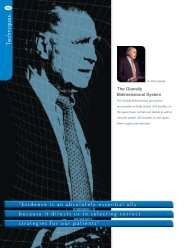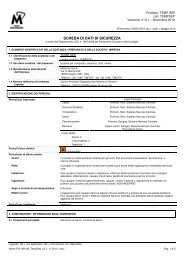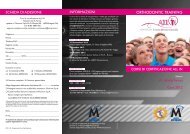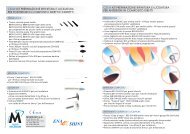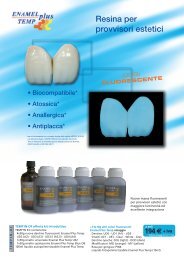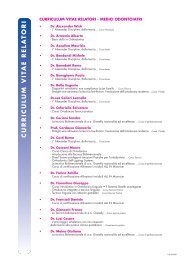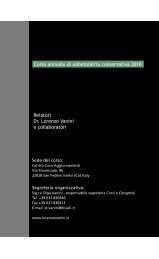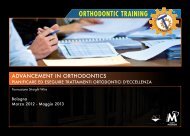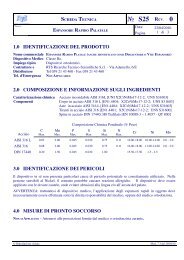Alexander DOC brochure.indd
Alexander DOC brochure.indd
Alexander DOC brochure.indd
You also want an ePaper? Increase the reach of your titles
YUMPU automatically turns print PDFs into web optimized ePapers that Google loves.
ALEXANDERLTSLONG TERM STABILITYthe <strong>Alexander</strong> Principles System
<strong>Alexander</strong> LTS SystemIn the world of Evidence Based Orthodontics, few systems stand on the mountain of data that supportsthe <strong>Alexander</strong> LTS System. For over 40 years the <strong>Alexander</strong> methodology has provided patients quick,beautiful, and stable results. Today, the system shows not only recent successfully treated cases,but stability over decades.Beautiful FinishJust about anyone can fly a plane, but landing one…that’s a different story. Thesame could be said for orthodontics. Moving teeth isn’t complicated, but properalignment and occlusion is what separates orthodontists from their peers andmakes them specialists.The <strong>Alexander</strong> LTS System embraces the logic of biologically compatible forces,but does so without compromising control. This is accomplished by using largewires early in treatment, while allowing inter-bracket distance to reduce the force.The result is rapid tooth movement under the complete control of the orthodontist.The proven <strong>Alexander</strong> technique allows for a beautiful finish with proper occlusionin minimal time.A LEXANDERLTSLONG TERM STABILITYThe 20 Principles of the <strong>Alexander</strong> Discipline1 Effort Equals Results
F a s t a n d S i m p l eWhile treatment outcomes must always come first, speed, simplicity, and efficiency are critical to the modern productive office. The <strong>Alexander</strong> methodologyonce again proves advantageous. By customizing the treatment plan to each patient, the <strong>Alexander</strong> LTS System allows the doctor to front load the hands-ontreatment and “let it cook.”10 years, 0 months 11 years, 8 months2 There Are No Little Things 3 Keep it Simple, Sir 4 Establish Goals for Stability
S t a b l e F i n i s hWhat should orthodontic patients expect from their doctor, lifetime retention or lifetime stability? While no one can truly offer lifetime stability, the skilledorthodontist armed with the proper tools can build a stable foundation that lasts for decades.The <strong>Alexander</strong> methodology builds stable results by building the smile around the lower anterior teeth as opposed to the upper “social six.” By using thespecifically designed lower anterior LTS bracket, the doctor is able to correct rotations, control labial flaring, and separate the lower incisal roots. Sinceboth arches are into finishing wires earlier in treatment, teeth settle and stabilize long before retention is even a consideration.C l a s s I ID i v i s i o n IN o n - E x t r a c t i o nA L E X A N D E RLTSL O N G T E R M S T A B I L I T Y5 Plan Your Work, Then Work Your Plan 6 Use Brackets Designed for Specific Prescriptions
11 years, 0 monthsTreatment Time - 26 monthsPost Treatment - 31 yearsPost Retention - 28 years7 Build Treatment into Bracket Placement 8 Exploit Growth to Obtain Predictable Orthopedic Correction
EvidenceWith millions of patients treated using the <strong>Alexander</strong> methodology, evidence of its effectiveness value is easy to find. Forthe past 40 years, The <strong>Alexander</strong> Room of Truth has amassed 15,000 cases. From these, over 50 research studies havebeen conducted.7 years, 6 monthsEnd of Phase I Treatment - 12 monthsSkeletal Class IIOpen Bite High AngleBimaxillary ProtrusionNon-ExtractionA LEXANDERLTSLONG TERM STABILITY9 Establish Ideal Arch Form 10 Follow a Logical Arch Wire Sequence
Beginning of Phase II TreatmentEnd of Phase II Treatment - 12 monthsPost Treatment - 9 yearsPost Treatment - 15 yearsPost Retention - 12 years11 Consolidate Arches Early in Treatment 12 Ensure Complete Bracket Engagement and Maintain Consolidation
T h i n k A b o u t I tThe <strong>Alexander</strong> system is the only system providing different bracket architecture for different teeth.Twin brackets are used on flatter teeth which benefit from additional control. Yet, small singlebrackets with wings are used on teeth with more labial curvature where twin brackets are not asefficient. This unique concept lies at the foundation of The <strong>Alexander</strong> Discipline: keep all aspectsof treatment as simple as possible.The LTS System includes Maximum Retention photo etchedbands, adding 41% more surface area to virtually eliminateloose bands. The medium temper and highly anatomicaldesign create a tight fit every time, while reducedinterproximal heights minimize tissue impingement.Rotation wings provide precise rotationalcontrol through the activation, deactivationor removal of individual wings.Maximum interbracket distance allows engagement of largerwires earlier in treatment for efficient leveling and fasterprogression into final arch wires.Rectangular wire used early in treatment,combined with maximum interbracket distanceprovides increased torque control, patientcomfort, and fewer appointments.A L E X A N D E RLTSL O N G T E R M S T A B I L I T Y13 Let It Cook! 14 Level the Arches and Open the Bite with Reverse Curve Arch Wires
T h e A l e x a n d e r * L o n g Te r m S t a b i l i t y S y s t e m.018 .022Maxillary Torq Ang Rot M-D R/L No hook With hook No hook With hookCentral +15 +5 0 Diagonal twin .140 R 390-1214 390-1216L 390-1215 390-1217Lateral +9 +9 0 Diagonal twin, hook D-G .100 R 390-1063 390-1063B 390-1073 390-1073BL 390-1064 390-1064B 390-1074 390-1074BCuspid -3 +10 0 Lang, 6.5 mm .050 R 390-3000 390-3000B 390-3200 390-3200BL 390-3001 390-3001B 390-3201 390-3201B1st -6 0 0 Raised wing, 5.5 mm .050 R/L 390-3607M 390-3607MB 390-3627M 390-3627MBBicuspid-6 0 0 OFFSET - Raised wing, 5.5 mm .050 R/L 390 -8637M 390-8637MB 390-8657M 390-8657MB2nd -8 +4 0 Raised wing, 5.5 mm .050 R 390-3307M 390-3307MB 390-3327M 390-3327MBBicuspid L 390-3308M 390-3308MB 390-3328M 390-3328MB-8 +4 0 OFFSET .050 R 390-8347M 390-8347MB 390-8367M 390-8367MBRaised wing, 5.5 mm L 390-8348M 390-8348MB 390-8368M 390-8368MB1st -10 0 +13 Direct bond single convertible with distal extension 3.5mm R 957-870C 957-872CMolar L 957-871C 958-873C2nd -10 0 +10 Low Profile direct bond with distal extension 3.2mm R 951-2005C 951-2025CMolar L 952-2006C 952-2026CMandibularCentral -5 +2 0 Curved wing, 4.5 mm .050 R 390-3309M 390-3329ML 390-3310M 390-3330MLateral -5 +6 0 Curved wing, 4.5 mm .050 R 390-3311M 390-3311MB 390-3339M 390-3339MBL 390-3312M 390-3312MB 390-3340M 390-3340MBCuspid -7 +6 0 Lang, 6.5 mm .050 R 390-3004 390-3004B 390-3204 390-3204BL 390-3005 390-3005B 390-3205 390-3205B1st -7 0 0 Raised wing, 5.5 mm .050 R/L 390-3350M 390-3360MB 390-3351M 390-3361MBBicuspid-7 0 0 OFFSET - Raised wing, 5.5 mm .050 R/L 390-8350M 390-8360MB 390-8351M 390-8361MB2nd -9 0 0 Raised wing, 5.5 mm .050 R/L 390-3370M 390-3380MB 390-3371M 390-3381MBBicuspid-9 0 0 OFFSET - Raised wing, 5.5 mm .050 R/L 390-8370M 390-8380MB 390-8371M 390-8381MB1st -10 0 0 Direct bond mini convertible 3.5mm R 955-311CM 955-313CMMolar L 956-310CM 956-312CM2nd 0 0 +5 Low Profile direct bond with distal extension 3.2mm R 953-3000C 953-3002CMolar L 954-3001C 954-3003C15 Create Symmetry 16 Use Intraoral Elastics to Coordinate the Arches
<strong>Alexander</strong> LTS Wire RecommendationsMaxillary Mandibular Treatment PhaseArch wire shownclose to actual size.017 x .025 Therma-Ti Lite 857-943A W 857-953A W Initial treatment wire.016 Force I NiTi 857-506A W 857-516A W Initial treatment wire.016 x .022 8 Stranded 857-902A 857-912A OPTIONAL Initial treatment wire.017 x .025 Twist Wire 857-236A 857-256A OPTIONAL Initial treatment wire.016 Stainless Steel 853-236A W 853-246A W Transitional non-extract space closure.016 x .022 Stainless Steel 853-201A W 853-221A W Transitional arch levelingAdd “W” to part number forindividually packaged arch wiresW.017 x .025 Force I NiTi 857-537A W 857-547A W Transitional arch leveling.017 x .025 Beta Titanium 857-672A W 857-682A W Transitional arch leveling.019 x .025 Beta Titanium 857-674A W 857-684A W Transitional arch leveling -.022 user.017 x .025 Stainless Steel 853-204A W 853-224A W Transitional Extraction Space Closure/Finishing.019 x .025 Stainless Steel 853-207A W 853-227A W Transitional Extraction Space Closure/Finishing - .022 UserWeldable Buccal Tube OptionsMaxillary Torq Ang Rot M-D R/L .018 .0221st -10 0 13 Convertible double/.045 headgear occlusal 3.5mm R 004-617CM 004-619CMMolar L 004-618CM 004-620CM2nd -10 0 10 Low profile single 3.2mm R 004-2005C 004-2025CMolar L 004-2006C 004-2026CMandibular1st -10 -6 opt. 0 Convertible lip bumper tube 4.2mm R 004-584LB 004-586LBMolar on band L 004-585LB 004-587LB2nd 0 0 5 Low profile single 3.2mm R 004-3001C 004-3003CMolar L 004-3000C 004-3002CA LEXANDERLTSLONG TERM STABILITY17 Use Nonextraction Treatment When Possible 18 Use Extraction Treatment When Necessary
Dr. Wick <strong>Alexander</strong> (center) with (from left to right)Drs. Chuck (son), C. Moody (brother),Cliff (nephew), and J. Moody (son) <strong>Alexander</strong>.A comprehensive book, written by Dr. Wick <strong>Alexander</strong>, details the 20 clinicalprinciples for effective orthodontic treatment and long term case stability. ThePrinciples are well supported by case studies, with many showing 25 to 30 yearspost-treatment data. An excellent resource for anyone in the field of orthodontics.Part #300019 Careful Appliance Removal, Followed by Retention Will Improve Stability 20 Create Compliance




